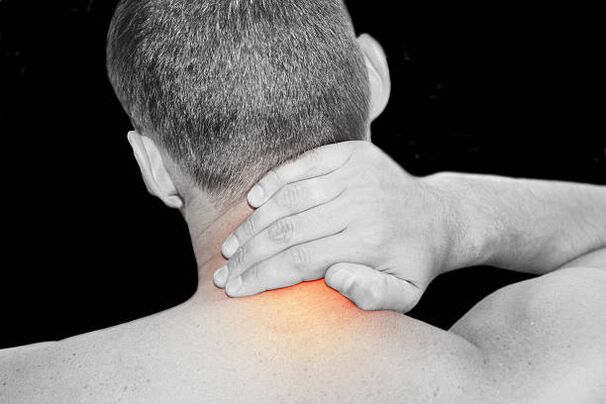Osteochondrosis of the cervical spine is a degenerative-dystrophic pathology affecting the vertebrae, cartilaginous discs and ligaments.If we decipher the term literally, osteo means “bone”, chondrosis means “cartilage”.This.Cervical osteochondrosis is associated with changes in the tissue structures of the spine, in which the intervertebral discs lose their functionality and at the same time the nutrition of the vertebral bodies themselves is disrupted.
Cervical osteochondrosis, the symptoms and treatment of which we will consider today, is a fairly common disease.According to statistics, osteochondrosis is detected after 35 years in 40-85% of the population, regardless of the standard of living and country of residence.The proportion of pathologies of the cervical spine is up to 30% of all identified cases.
Most often, the disease develops in the C 5 - C 7 region, as these are the most mobile and important vessels that supply the brain and can be involved in the disease process.

Symptoms of cervical osteochondrosis
The symptoms of cervical osteochondrosis are diverse, and the clinical manifestations depend on which vertebra is affected by the disease.Osteochondrosis of the neck is characterized by sudden “shots”, during which the patient feels a sharp pain that limits movement and a crunching sound when turning the head.Let's consider the pain symptoms of osteochondrosis of the cervical spine depending on the location of the vertebral lesions:
- 1. Vertebra – Pain and numbness in back of head;
- 2nd vertebra - pain in the back of the head, discomfort in the vertex area;
- 3 vertebrae - neck pain, possible speech impairment, sensitivity and innervation of the tongue;
- 4 vertebrae - decreased neck muscle tone, headache, difficulty breathing, pain in the shoulders, shoulder blades, in the heart area, right hypochondrium;
- 5-6 vertebrae - pain in the shoulders, forearms, scapula, thumbs;
- 7. Vertebra – Pain in the scapula, hand, 2-4 fingers, possible loss of sensitivity in these areas.
With extensive osteochondrosis affecting multiple vertebrae, symptoms may overlap, making accurate diagnosis difficult.
Dizziness in cervical osteochondrosis deserves special attention, as it is the main symptom of the disease.It comes on suddenly and can be quite severe.
Headaches in cervical osteochondrosis may be accompanied by dizziness and cannot be relieved with analgesics, as they are a consequence of compression of the vertebral arteries.Muscle pain in cervical osteochondrosis is not always present, but headaches can be a constant symptom.
Vertebral artery syndrome with cervical osteochondrosis
Vertebral artery syndrome with cervical osteochondrosis occurs against the background of compression of the vertebral arteries and includes many manifestations:
- debilitating headache that worsens when turning or tilting the head;
- Visual impairment: double vision, reduced sharpness, feeling of pain and dryness of the eyes, flickering of spots;
- Symptoms such as angina pectoris complain of chest pain, shortness of breath and changes in blood pressure.It is very important to correctly and timely differentiate the diagnosis, since angina pectoris and syndromes associated with cervical osteochondrosis are treated not only with different drugs, but also with different specialists;
- short-term hearing loss - the sudden onset of noise or ringing in the ears, accompanied by short-term dizziness and darkening of the eyes;
- Vomiting and accompanying impaired consciousness are possible.Most commonly, such signs are caused by sudden bending or turning of the head;
- Brain disorders similar to an ischemic stroke.Here too, timely differentiated diagnosis is very important.
Treatment of cervical osteochondrosis
Treatment of cervical osteochondrosis of the spine begins only after a detailed medical examination.Diagnosis is made using x-rays of the neck, as well as modern methods – CT or MRI of the spine.If the diagnosis of cervical osteochondrosis is confirmed, treatment is carried out by a neurologist.At the first manifestations of the disease, drugs can be prescribed only during the exacerbation phase.The basics of therapy during the remission phase are physiotherapy, massage and correction of the patient's treatment plan.
Treatment of osteochondrosis of the cervical spine includes several mandatory aspects:
- Mode correction.You need to properly organize your night's rest;It is advisable to use orthopedic pillows.
- Exclusion of burdens.If you spend your entire working day at a desk, take a few minutes every two hours to stretch your neck and also do eye exercises.
- drug therapy, taking medications prescribed by the doctor.Here, too, we strongly recommend that you do not seek the advice of local doctors.
- physiotherapeutic procedures.You will receive a referral from a neurologist and detailed therapy will be prescribed by a doctor-physiotherapist.Don't be seduced by the promises of unprofessional masseurs.Remember that the neck is a very responsible department.If massages or manual procedures are carried out by a layperson, complications can arise.
A lot of literature has been written about how to treat osteochondrosis in the cervical spine using traditional methods.Be careful, other folk recipes do not stand up to criticism.Discuss any method of traditional therapy with your doctor before using it.



























